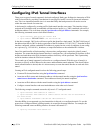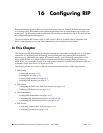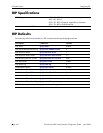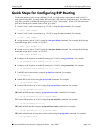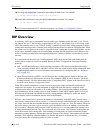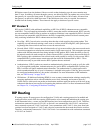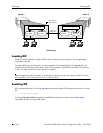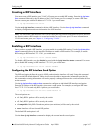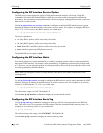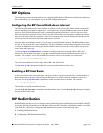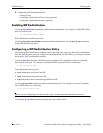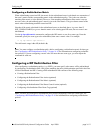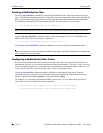
Configuring RIP RIP Routing
OmniSwitch 6600 Family Network Configuration Guide April 2006 page 16-5
RIP deletes routes from the database if the next switch to that destination says the route contains more
than 15 hops. In addition, all routes through a gateway are deleted by RIP if no updates are received from
that gateway for a specified time period. If a gateway is not heard from for 180 seconds, all routes from
that gateway are placed in a hold-down state. If the hold-down timer value is exceeded, the routes are
deleted from the routing database. These intervals also apply to deletion of specific routes.
RIP Version 2
RIP version 2 (RIPv2) adds additional capabilities to RIP. Not all RIPv2 enhancements are compatible
with RIPv1. To avoid supplying information to RIPv1 routes that could be misinterpreted, RIPv2 can only
use non-compatible features when its packets are multicast. Multicast is not supported by RIPv1. On inter-
faces that are not compatible with IP multicast, the RIPv1-compatible packets used do not contain poten-
tially confusing information. RIPv2 enhancements are listed below.
• Next Hop—RIPv2 can advertise a next hop other than the switch supplying the routing update. This
capability is useful when advertising a static route to a silent switch not using RIP, since packets pass-
ing through the silent switch do not have to cross the network twice.
• Network Mask—RIPv1 assumes that all subnetworks of a given network have the same network mask.
It uses this assumption to calculate the network masks for all routes received. This assumption prevents
subnets with different netmasks from being included in RIP packets. RIPv2 adds the ability to specify
the network mask with each network in a packet. Because RIPv1 switches ignore the network mask in
RIPv2 packets, their calculation of the network mask could possibly be wrong. For this reason, RIPv1-
compatible RIPv2 packets cannot contain networks that would be misinterpreted by RIPv1. These
networks must only be provided in native RIPv2 packets that are multicast.
• Authentication—RIPv2 packets can contain an authentication key that may be used to verify the valid-
ity of the supplied routing data. Authentication may be used in RIPv1-compatible RIPv2 packets, but
RIPv1 switches will ignore authentication information. The authentication is a simple password in
which an authentication key of up to 16 characters is included in the packet. If this key does not match
the configured authentication key, the packet is discarded. For more information on RIP authentica-
tion, see “RIP Security” on page 16-14.
• IP Multicast—IP Multicast Switching (IPMS) is a one-to-many communication technique employed by
emerging applications such as video distribution, news feeds, netcasting, and resource discovery.
Unlike unicast, which sends one packet per destination, multicast sends one packet to all devices in any
subnetwork that has at least one device requesting the multicast traffic. For more information on IPMS,
see Chapter 26, “Configuring IP Multicast Switching.”
RIP Routing
IP routing requires IP router ports to be configured on VLANs and a routing protocol to be enabled and
configured on the switch. RIP also requires a RIP interface to be created and enabled on the routing port.
In the illustration below, a router port and RIP interface have been configured on each VLAN. Therefore,
workstations connected to ports on VLAN 1 on Switch 1 can communicate with VLAN 2; and worksta-
tions connected to ports on VLAN 3 on Switch 2 can communicate with VLAN 2. Also, ports from both
switches have been assigned to VLAN 2, and a physical connection has been made between the switches.
Therefore, workstations connected to VLAN 1 on Switch 1 can communicate with workstations connected
to VLAN 3 on Switch 2.




